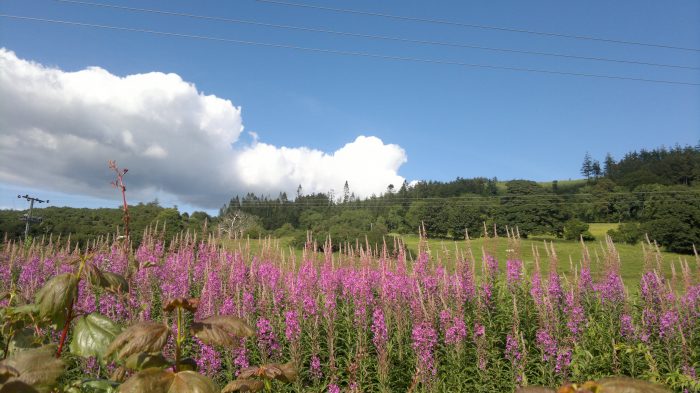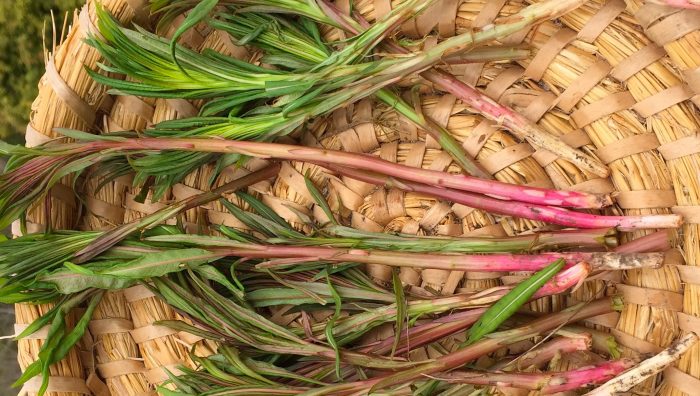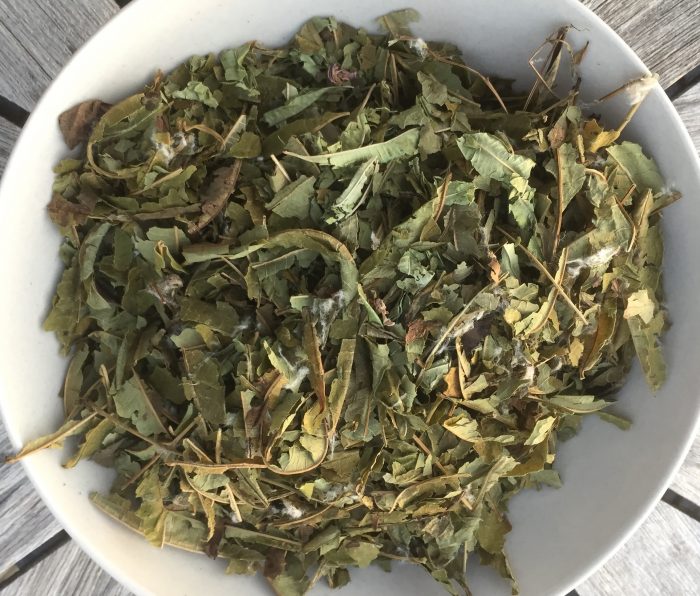Rosebay Willowherb/Fireweed – Edibility, Identification, Distribution, Ecology, Recipes
Chamaenerion angustifolium or Epilobium angustifolium
Generally known in the UK as rosebay willowherb, usually known in N America as Fireweed
Identification – 4/5 – Perennial, growing from rhizomes. Shoots look like tiny palm trees with pink stems, mature leaves are lanceolate (long and thin) similar to willow leaves (hence the name) growing alternately in a spiral formation around the red tinged stems; fully mature grows up to about 1.5m tall in summer (often taller). Pink 4 petalled flowers (2-3cm) bloom progressively from bottom to top, with individual flowers 2 to 3cm across. Long seed pods also mature progressively up the flowering spire, releasing drifts of fine haired wind-dispersed seeds. Highly gregarious – its normal to see large ranks of rosebay willowherb.
Lookalikes – Although it is not really very similar at all, when harvesting you should stay attuned and be careful not to gather that other common pink flowering plant that is very poisonous, foxglove. There are other closely related willowherbs, notably greater and lesser willowherb. These lack the distinctive flowering spires, and can be used in similar ways to rosebay willowherb, though they are not generally considered so tasty. They tend to favour riverbanks and wet ground.
Edibility – Multiple edible parts/stages: Very young shoots 3/5; Pith of mature pre-flowering stems 3/5; Flowers 2/5; Mature leaves and flowers fermented as tea 4/5. The roots have also been used as food, which suits such a hyper abundant plant, but this strikes me as too efforty unless you are in a survival situation.
Distribution – 5/5 – Very common. The small airborne seeds are carried for many miles on the wind and in the vortices created by trains and cars.
Habitat – Hedgerows, waste ground, verges, railway embankments, disturbed ground and usually the first colonisers of fire sites.
Season – March/April (shoots) to July/August (flowers & mature leaves)
Ecology – An important pioneer plant, colonising damaged and disturbed ground. Usually succeeded after about 5 years. Seeds can remain dormant in soil for many years, and do well in mineral soil stripped of organic top layer by (eg) fire. Pollinated by bees and especially moths, the larvae of which also feed on the leaves.
Sustainable Harvesting Considerations:
For such a prolific, quick growing, fast-colonising plant, that has so many seeds lying dormant in the soil at any given time, its hard to imagine anyone getting too worried about over harvesting. In many areas this plant could support commercial harvesting, and indeed in areas of Canada Fireweed Syrup is a healthy cottage industry. But foragers will be the first to notice, when gathering the flowers, just how important these plants are to bees, and bees are only their most noticeable visitor – moths visit them at night, using them as both food and nursery. Still it would be very hard to make any noticeable impact (well…you’d need to be an awful lot more patient than me!). Nevertheless, this is a good plant with which to practice what I call The 100th Portion: take only 100th of what you encounter in any given area. You are probably wondering how to gauge 100th. Start by visualising 1/10th of the what you see in the area you plan to harvest from – 1/10th is about the smallest fraction humans can easily get a feel for. Then imagine what 1/10th of your imagined 1/10th looks like. You are picturing 100th.

Rosebay Willowherb flowers and leaves, late July, Scotland. Note how the flower buds open in succession from the bottom to the top of the spire
Rosebay willowherb, or fireweed as they call it over the pond, is the provincial plant of Yukon territory in Canada, where enormous drifts of their pink flowers often colonise the sites of large forest fires for as far as the eye can see. Its a truly breathtaking phenomenon, creating a shimmering pink haze that once seen is never forgotten. This important ecological pioneering role is echoed in it other English names of bombweed or blitzweed, after it was the first plant to make home on World War II bombsites..
It is well loved by my relatives in Canada for making a pink syrup (and from that, a jelly) from the flowers in summer. I know some people value pretty pinkness over flavour, but personally I think the flowers are its least exciting food use. Having said that, my friend Peter is a fan, and reckons that if you use enough flowers you end up with a fruity tasting syrup. You can read his recipe below.
Rosebay Willowherb – Young Shoots
Personally i’m more interested in the young shoots in the spring, a decent wild vegetable that can be gathered easily in large quantities provided you take a note of their colonies the previous year when they are showing off their glorious pinkness. Return to these locations in late March or April of the following year to catch their new palm-tree-like shoots emerging, with their tender pink stems. You need to be on the ball, and anticipate this step of nature’s dance, as they are quick growing and soon move from tender and juicy to tough and fibrous. Their season of deliciousness is often no longer than two or three weeks.
Try to catch them while most of the leaves point upwards, and before too many start to flop down. The best places to gather them are where they have forced their way up through leaf litter, which makes their pink stems grow long and tender.
They tend to start appearing at about the same time as common hogweed shoots, and while they certainly aren’t in the same league in terms of flavour, they do partner up nicely in stir fries, a milder flavour next to more pungent spring vegetables. Peeled they are pleasing raw and good for dipping in wild garlic pesto or hummus. Think of them in the kitchen as along the lines of a mild baby asparagus shoot – though not so tasty. If you miss their short season of tenderness, or stumble on a patch that happens to be a bit stringy (which happens) a bit of peeling may keep them worthwhile.
Eat the whole shoot – stem and young leaves.
Rosebay Willowherb – Stem Pith
All too quickly the stems are too big and fibrous to enjoy as a vegetable, but the mature stems, up to when the flower buds start to open, can be split down the middle and their sweet, cucumbery pith scraped out and eaten as is, or used to enrich soups, stews and smoothies.
Rosebay Willowherb – Tea – Ivan’s Chai
Perhaps their tastiest use is to make mature leaves into a richly flavoured black tea, often known as “Ivan’s Chai” as it was (and still is) widely drunk in Russia. It has been used traditionally to treat all manner of ailments, but I drink it mostly because its tasty! Its very easy to make:
- Collect the mature leaves up to and including when they come into flower, or even as they start to turn a bit rusty in August/September. Just strip off the leaves (and some flowers are fine too, but the flavour comes mostly from the leaves) from the stem.
- Bruise the leaves by wringing them in your hands and generally smooshing them about a bit.
- Lightly ferment the leaves/flowers by leaving them in a carrier bag in a warm place for a few days, until they start to go “foosty” and discolour.
- Finally dry them gently (a dehydrator on a low setting, or hang them in a sunny window).
- The resulting tea is delicious, with the smell of green tea, and much of the richness of traditional black teas, but it contains no caffeine.
Rosebay Willowherb Flowers – Syrup, Jam or Jelly
As I mention above, pinkness aside, I find the flowers the least gastronomically interesting part of this wonderful plant. But several million Canadians can’t be wrong, and certainly not my friend and fellow foraging teacher Peter Studinski , who insists its well worth the trouble if you follow his recipe. I think the key is to pick a gigantic number of flowers, and I just don’t have the patience. Here is his recipe in his own words:
I’ve found that a carrier bag full of flower heads makes just over a litre of syrup. You need to bring the flowers to a boil. Infusing in warm/hot water or a sugar syrup doesn’t work and just gives a weak syrup.
Strip the flowers off the stems. I also added some of the unopened flower buds at the top of the stem.
Avoid getting leaves in as they are bitter although a few won’t make a difference. Avoid getting the pods below the flowers in as they are bitter.
Cover the flowers in plenty of water. I had about twice as much water to wet flowers. More water is better than too little as you need to reduce it down anyway.
Bring this to a summer. As soon as the colour comes out of the flowers (they go white/grey) strain the hot liquid off. Don’t leave the flowers in otherwise it’ll go very bitter. The liquid will be an unattractive brown colour.
Hard boil the liquid down to reduce it. As it starts boiling add some lemon juice. Here’s the trick – the lemon juice turns the colour to a deep red as well as adding flavour. Add enough lemon so you see a colour change. The colour will deepen as you reduce. Add more later to taste. I also added a little orange zest.
Reduce the liquid to about half or to whatever level seems to taste best. I then put this trough a coffee filter to get all the little bits out. Then add sugar to taste. I also added a couple of pinches of salt, but I like a bit of salt 🙂
Once you have made a syrup, its easy to flavour a jelly with it.
To make your syrup into a jam, just add lots of jam sugar (2 sugar : 1 water and pectin (dock stems work well for setting jams).
Related Posts:





8 Comments
Hi there It is a great plant!:)
But just to let u now, that it is not good to dry it on direct sunshine. It’s the best to keep it dry, warm, dark.
After reading “Are wild and cultivated flowers served in restaurants or sold by local producers in Denmark safe for the consumer?”
https://bit.ly/3EuJyiW
… I am rather less happy about my fireweed tea and will probably chuck it out.
Ditto my nasturtium vinegar from the River Cottage preserves book. I have seen nasturtiums recommended as pesto (leaves), in salad/vinegar (flowers) & as ‘capers’ (seeds) but per https://www.botanical-online.com/en/medicinal-plants/capuchina-toxicity it is considerably toxic – & contraindicated in the common disorder hypothyroidism (which I have). No word of any of this in the River Cottage book.
The Danish scientific article also raises question the safety of many commonly foraged plants. Any thoughts on this topic?
Hi Felicity, thanks for sharing this.
I’ve written about what I call the “Spectrum of Edibility” here: https://gallowaywildfoods.com/the-day-i-ate-a-deadly-plant-the-spectrum-of-edibility/
It is pretty easy to raise questions about the safety of almost any plant – foraged or cultivated. but the key points tend to be dosage and personal tolerances – something that is noted in the articles. Note that the second article you refer to points out similar compounds in watercress, mustard and cabbage to those they are calling “toxic” in nasturtium.
The first article, while appearing more scientific, doesn’t seem to draw any new conclusions to that which is widely taught and discussed among those who use the plants mentioned. Many of the possible issues it raises are based on force-feeding rats very large doses over a sustained period. The usefulness of drawing comparisons between such research and humans thoughtfully eating sensible amounts of these plants as part of a biodiverse diet has to be questionable. See Monica Wilde’s discussion of comfrey for more insight into this (https://monicawilde.com/is-comfrey-edible/):
” Dangerous actions are sometimes attributed to herbs because of in vitro or animal studies. And yet many papers that demonstrate actions in vitro or in animals cannot always be replicated in vivo – i.e. in humans. Animals and humans are not the same. In the Hirono study, the researchers found that forcing rats to eat huge quantities of ground comfrey leaves and roots did them no good at all – especially the 2 week old baby rats. Of note, out of 28 rats fed 8% of diet as dry weight comfrey, one showed a liver tumour at 600 days (a long life for a rat!). The average adult human would probably need to ingest 20,000 comfrey leaves to produce a comparative dose. Assuming 3 dried leaves of comfrey per cup of leaf tea, this equates to drinking 6,666 cups of tea. If you drank a cup of comfrey leaf tea every single day, it would take you over 18 years to reach this level of consumption!”
I see nothing in either report that will alter my personal consumption of any of the plants mentioned – as I use them in a considered way, in appropriate quantities as part of a biodiverse diet. I may re-evaluate some should I develop, say, hyperthyroidism. But I totally respect your decision to exercise caution.
As foraging becomes more popular, there is no doubt that new insights into the benefits and issues around different plants will come to light. At present, as clearly demonstrated in the first article, the lack of commercial profitability around wild harvests mean that many have not received the expensive scientific analysis that commercial crops have. Neither have they had marketing agencies promoting them – or placing any issues into clearer context.
For this, and lots of other reasons, its virtually impossible for any wild food focussed book or website to fully explore every possible contraindication for a particular plant. Its for readers to apply the limited insight provided to their personal context, as you have done here.
I am currently working with food scientists, ecologists and other foragers on an education, benchmarking and accreditation scheme around commonly consumed wild foods that will promote clearer understanding around safe usage and sustainable harvesting practices, based on multiple sources and practical experience.
Best wishes,
Mark
Is this herb good for prostate enlargement, if so, were do l get it in Nigeria.
Yes, I believe some herbalists do recommend it to support rotate health, but I am no expert on that – best to consult a herbalist. I have even less knowledge of the flora of Nigeria!
I have some fireweed growing nearby. I have noticed something strange with some of the plants. More than a few of them have multiple heads branching off near the top of the stem, maybe 2 extra on each plant. Is this a normal thing for fireweed? I’ve not noticed this in any photos or identification guides
Actually i’ve had another look and one of the plants i checked have what looks like a dozen mini heads branching out before the main head, with what looks like the pink buds of the flowers. It’s only on some plants. Is this common for fireweed or is this a plant variation?
Hi Paul,
Sounds like it may be another variety of willowherb – check out greater willowherb or hairy willowherb etc.
Mark.